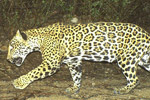Hunting, deforestation decimated species in Mexico; reintroduced macaws have high survival rate
While listed as Least Concern by the IUCN, the scarlet macaw (Ara macao) has disappeared from almost all of its native range in Mexico, is very rare in most Central American countries, and is locally extinct in El Salvador. A new paper published this week in mongabay.com’s open-access journal, Tropical Conservation Biology, finds a reintroduction program was hugely successful in its first year of operation, with a 92 percent survival rate for released birds.
Scarlet macaws are native to areas throughout much of the Neotropics, a region that encompasses the tropical regions of the New World. However, hunting pressure and habitat loss have taken their toll on the species, resulting in local and regional extinction in many areas. In Mexico, its range has been reduced 98 percent, with isolated handfuls of macaws present in the states of Chiapas and Oaxaca, and along Mexico’s border with Guatemala and Belize. While the species as a whole is listed as Least Concern by the IUCN, one subspecies (A. macao cyanoptera) is considered threated with extinction by CITES and is classified as “endangered” by the government of Mexico.
In all, only about wild 450 scarlet macaws existed in and near Mexico as of 2013.
Scarlet macaws (Ara macao) in Belize. Photo by Rhett A. Butler.
A decade of effort between local communities, conservation organizations, and even the Mexican Army has put a stop to much of the deforestation that wiped out macaw habitat. Still, the once-range of the scarlet macaw continues to lose its forests, with 1.7 million hectares of tree cover lost between 2001 and 2013 – or nearly 5 percent of its forests, according to Global Forest Watch.
Because of its decline, the IUCN recommended a strategy for population restoration in Mexico in 2013 through reintroduction of macaws to places that had lost them entirely, and reinforcement of small macaw populations with more individuals. By doing this, the IUCN hoped that the scarlet macaw would become reestablished in Mexico.
In April 2013, the first scarlet macaws were released in Aluxes Ecopark Palenque near Palenque National Park, marking the first time scarlet macaws have flown wild in the park in nearly 70 yeas. The researchers chose the site in part due to its status as an ecological and archaeological stronghold.
“Because Palenque National Park harbors one of the most important archaeological sites of the ancient Maya civilization, a great deal of public awareness exists of the importance of preserving the biodiversity-rich tropical rainforest of PNP and the ancient Mayan ruins found within; this interest has been extended as well to the remaining forest fragments in the region,” writes Alejandro Estrada, the paper’s author and research scientists at the National Autonomous University of Mexico. “Such awareness and interest have been sustained through annual programs of environmental education by CONANP (Commission de Areas Naturales Protegidas), the local division of the environmental agency of the government of Mexico.”

Historical (green) and current (red and yellow dots) distribution of Ara macao cyanoptera in Mexico. Red dot indicates approximate location of relict population of 150-200 scarlet macaws at the southeastern boundary of the Montes Azules biosphere reserve in Mexico, close to the border with Guatemala. Yellow dot indicates a presumed population of ca 50 individuals in the Chimalapas mountain region shared by the states of Oaxaca and Chiapas in Mexico. Map adapted by Estrada (2014) from Howell, S. N. G. and Webb, S. (1995).

The range of the scarlet macaw lost 5 percent of its forest between 2001 and 2013, despite anti-deforestation campaigns. Map courtesy of Global Forest Watch. Click to enlarge.
Most macaws chosen for release were young, captive-raised birds that had enough genetic variation to head off the risk of inbreeding depression and ensure survival of the population in the long-term. To help give the birds a good start, they were not released directly into the wild, but were gradually conditioned to their new environment through “soft release,” during which they were trained to recognize wild food and avoid humans and other predators.
After one year, 92 macaws had been released into the forests of Pluxes Ecopark Palenque. Of these, 85 survived, upping the population of wild scarlet macaws in Mexico by 34 percent. Some are already working on the next generation.
“A first successful nesting event took place on August 24th, 2014 in the released population of scarlet macaws. A female laid two eggs in an artificial nest box,” writes Estrada. “This suggests that the process of adaptation of the introduced macaws to the wild is proceeding well.”
According to Estrada, the reintroduction of scarlet macaws to Pluxes Ecopark Palengue not only improves the species’ situation, but is also a boon to the park’s ecology as well as local human communities.
“Importantly, the reintroduction of the scarlet macaw in Palenque will restore a seed and fruit-eating avian species with important consequences for ecosystem functions and processes, and will also serve to reconnect people with their natural heritage,” he said.
However, Estrada cautions that much still needs to be done to ensure the success of the reestablished macaws.
“The participation of the inhabitants of the urban and rural areas of the municipality of Palenque, as well as the support of the municipal, state and federal government, have been and will continue to be crucial to the success of the reintroduction project beyond its first year of implementation,” he said.
Citations:
- Estrada, A. 2014. Reintroduction of the scarlet macaw (Ara macao cyanoptera) in the tropical rainforests of Palenque, Mexico: project design and first year progress. Tropical Conservation Science Vol.7 (3): 342-364. Available online:
www.tropicalconservationscience.org
}}
Related articles
Fragmented forests hurt some bat species, may benefit others

(09/23/2014) Development of roads and other structures disturb large, continuous patches of habitat for wildlife. This habitat fragmentation is one of the biggest contributors to species extinction, as the local ecology and species interactions are altered. A new study finds that leaf-nosed bat abundances in Mexico are closely linked to how sensitive each species is to habitat fragmentation.
Is there hope for the vaquita? IUCN calls for action to save world’s smallest, rarest porpoise

(09/19/2014) Since the baiji was declared extinct in the early aughts, the vaquita has taken its unenviable position as the world’s most threatened cetacean. The tiny porpoise currently numbers around 100, with accidental entanglement in gillnets primarily responsible for its decline. In response, the IUCN recently issued a statement calling for immediate action to curb vaquita bycatch and head off its extinction – which otherwise may lie just around the corner.
‘Canary in the cornfield’: monarch butterfly may get threatened species status

(09/08/2014) Monarch butterflies were once a common sight throughout the North American heartland. But declines in milkweed – their caterpillars’ only source of food – have led to a 90 percent decline in monarch numbers. Now, the U.S. Fish and Wildlife Service is reviewing a petition that would grant the iconic species protection through the Endangered Species Act.
Seeking justice for Corazón: jaguar killings test the conservation movement in Mexico

(07/31/2014) Eight years ago, a female jaguar cub was caught on film by a motion-triggered camera trap set in the foothills of canyons, oak forest, and scrubland that make-up the Northern Jaguar Reserve, just 125 miles south of the U.S.-Mexico border. Three years later, in 2009, the jaguar reappeared on film as an adult. They called her ‘Corazón’ for the distinctive heart-shaped spot on her left shoulder.
Study finds tiny cloud forests have big biodiversity

(06/24/2014) Tropical cloud forests are situated in mountains and are characterized by the frequent presence of low-level clouds. Scientists have always regarded them as having high biodiversity, but a recent study adds a new dimension: it found cloud forests contain a significant and surprising array of tree and bromeliad species, even when they are relatively small.
Survey finds huge biological value in Baja California, stalls resort development

(06/11/2014) A recent survey conducted by researchers from the U.S. and Mexico has uncovered staggering levels of biodiversity in the delicate desert environment of Cabo Pulmo in Baja California. Their findings have stymied construction of a proposed $3.6 billion resort, but developers are not giving up.
U.S. citizens willing to spend billions to protect monarch butterflies

(04/03/2014) New research shows Americans are willing to pay for the protection of the ailing monarch butterfly, which is experiencing a steep decline in numbers. The study, published in Conservation Letters, found nearly three-quarters of those surveyed placed importance on conservation efforts for the iconic species.
Revealed for the first time: the surprising biodiversity of algae ‘reefs’

(03/28/2014) Most people are familiar with coral reefs, but very few have ever heard of their algal equivalent – rhodolith beds. Yet, these structures provide crucial habitat for many marine species. In the first study of its kind, published in mongabay.com’s Tropical Conservation Science, researchers unveil just how important these beds are for bottom-dwelling organisms, and the species that depend on them.
Researchers use new technique to shed light on endangered tapir

(03/26/2014) A new study, recently published in mongabay.com’s open access journal, Tropical Conservation Science, uses a new technique to examine the behavior and distribution of the Endangered Baird’s tapir (Tapirus bairdii) in the southern forests of Mexico. One of four species of Central American tapir, Baird’s tapir was recently ranked 34th on a list of 4,000 endangered animals in need of urgent protection by the Zoological Society of London.